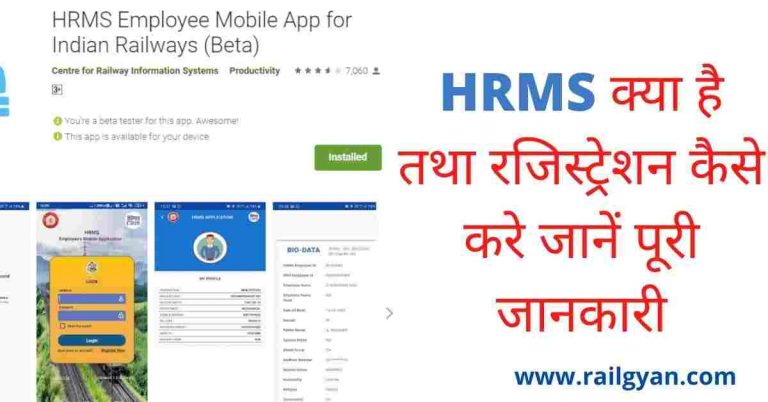HRMS in Indian Railways: A Guide to the Human Resource Management System
The Human Resource Management System (HRMS) is an enterprise resource planning (ERP) software designed to digitize and streamline human resource management processes for the Indian Railways. HRMS integrates HR activities such as recruitment, training, payroll, and more onto a unified platform.
An Overview of HRMS in Indian Railways
HRMS was launched in 2014 under the Ministry of Railways to modernize and improve HR processes. The main objectives of HRMS are:
- Transition HR operations from manual to digital
- Centralize HR data and enable easy access to employee information
- Streamline recruitment, training, payroll, and other HR functions onto a single platform
- Enhance efficiency, transparency, and data-driven decision making in HR
By achieving these goals, HRMS aims to boost productivity, employee satisfaction, and data accuracy for India’s largest public sector organization. Currently, over 1.3 million employees of Indian Railways use the HRMS system.
Key Modules and Features of HRMS
HRMS integrates the following modules onto a unified platform:
1. Employee Master
The employee master database stores key information like employee ID, name, date of birth, gender, department, role, salary, and more. It acts as the core database for the entire system.
2. Recruitment
The recruitment module handles job openings, candidate applications, examinations, merit lists, appointment letters, and onboarding. It reduces paperwork and manual efforts involved.
3. Training and Development
This module manages training needs identification, program nominations, feedback, and tracking employee progress. It helps align training with organizational goals.
4. Employee Self Service (ESS)
ESS allows employees to access their data, apply for leave and reimbursements, submit requests, update details, and more directly through the HRMS portal. This empowers employees and reduces HR workload.
5. Payroll
The payroll module automates salary processing, income tax deductions, disbursals, and generating pay-slips accurately.
6. Performance Assessment
HRMS enables online performance evaluations, setting KRAs, reviews, feedback, and linking promotions.
7. Grievance Redressal
Employees can raise complaints and grievances online and track their status. This improves transparency.
8. Exit Management
HRMS manages retirement, resignation, termination, and other exits seamlessly by integrating with other modules.
9. Dashboards and Reports
HRMS provides insightful reports and analytics around recruitment, training, appraisals, attrition, demographics, and more.
Implementing HRMS in Indian Railways
Indian Railways began implementing HRMS in phases. The journey can be divided into:
Phase 1 (2014-2017) – Focused on stabilization of employee master data and development of ESS for employees to access their data
Phase 2 (2017-2019) – Implemented recruitment, training & development, and performance assessment modules.
Phase 3 (2020 onwards) – Current phase aims to onboard remaining modules and augment AI/ML for advanced analysis.
Over 17 zones of Indian Railways have adopted HRMS in a phased manner. Both corporate offices and divisional units access the centralized cloud infrastructure of HRMS.
Benefits of HRMS for Indian Railways
HRMS has delivered various benefits, including:
- Increased productivity – HRMS has reduced HR workload by 73% through automation. This has increased productivity.
- Cost savings – Indian Railways has saved INR 259 crores by digitizing processes and reducing paperwork. This is projected to reach INR 500 crores.
- Data accuracy – Centralized data and integration has eliminated duplication and improved data accuracy.
- Faster information access – Self-service allows employees to access their data anywhere without dependency.
- Better compliance – Digital record keeping has improved compliance with labor laws.
- Enhanced transparency – Grievances are addressed faster with better tracking and monitoring.
- Data-driven decisions – Analytics provides insights for data-driven recruitment, training, and other policies.
- Employee satisfaction – Digitization has made HR functions employee-friendly and reduced delays.
Thus, HRMS has delivered tremendous value. As remaining modules are onboarded and advanced analytics incorporated, HRMS is poised to strategically transform human resource management for Indian Railways.
Challenges in Implementing HRMS
However, HRMS implementation has also posed some challenges:
- Resistance to change – For an organization the size of Indian Railways, change management was critical. Extensive training and communication helped overcome cultural barriers.
- Connectivity issues – Lack of reliable connectivity in some remote centers led to accessibility issues that had to be addressed.
- Procedural delays – Rationalizing and standardizing HR policies across zones caused procedural delays initially.
- Integration complexity – Complexity arose while integrating HRMS with financial systems like Payroll due to high volume of transactions.
- Data security – Centralized data required robust security systems to be implemented. Data security remains a priority.
- Cost overruns – Due to evolving scope, HRMS saw some cost overruns during development. But savings generated later help offset this.
The Road Ahead
Currently in its third phase, HRMS aims to achieve the following in the coming years:
- Onboard remaining modules such as grievance management, exit management, and document management.
- Launch mobile access to make HRMS available on-the-go for employees.
- Enhance analytical capabilities by incorporating AI/ML for predictive analytics.
- Ensure UI/UX is seamless across devices and zones.
- Develop APIs to integrate HRMS with best-in-class third-party solutions.
- Implement robust cybersecurity and data protection mechanisms.
- Extend HRMS across all zones, divisions, and units in a time-bound manner.
- Continuously train employees and collect feedback to drive improvements.
As HRMS enhances in scope and sophistication, Indian Railways aims to set a benchmark in public sector digitalization. The implementation of HRMS exemplifies how centralized, cloud-based HR systems can help large organizations leapfrog into the digital era. This case study should provide key lessons for similar public sector organizations planning to modernize HR through technology.


